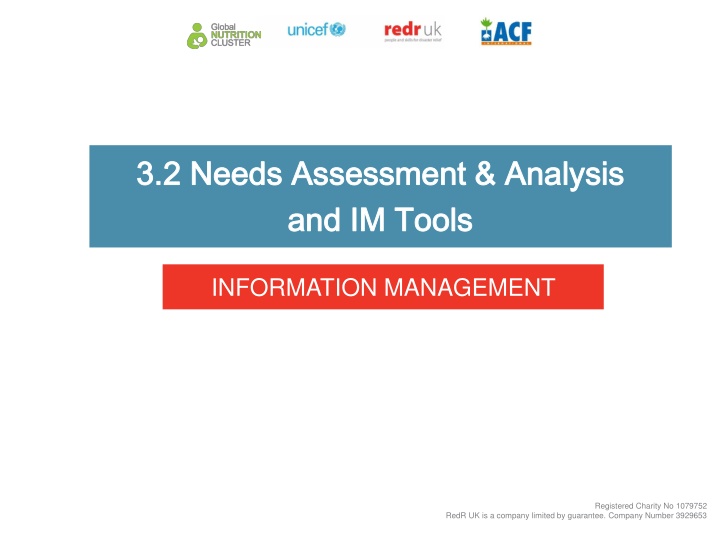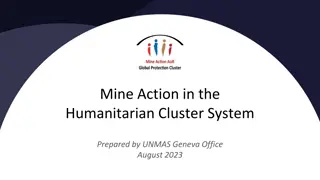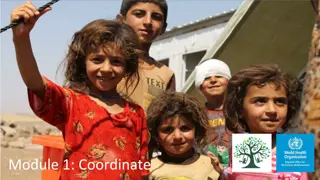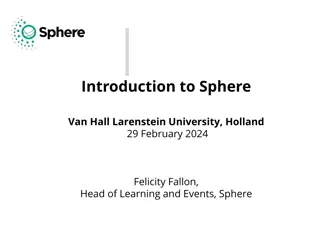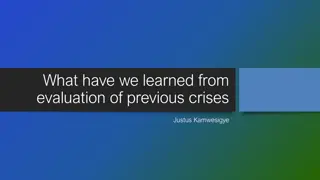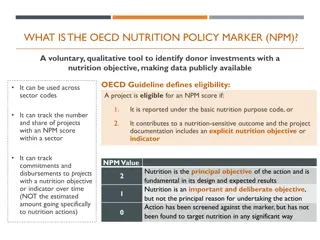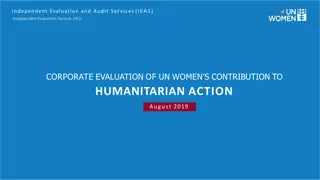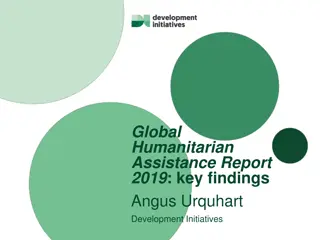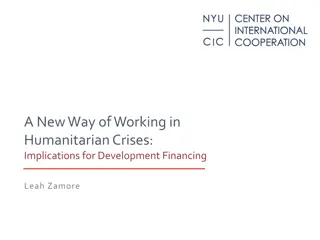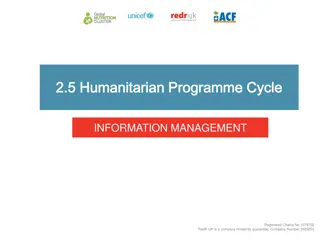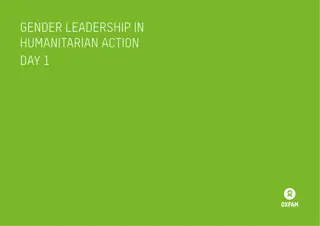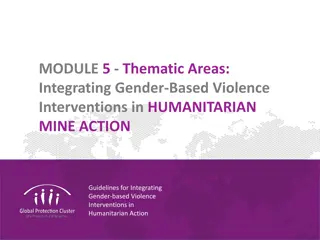Nutrition Information Sources for Needs Assessment in Humanitarian Program Cycle
Nutrition information for needs assessment in the Humanitarian Program Cycle can be sourced from large-scale national surveys like DHS and MICS. While such surveys provide valuable baseline data, limitations in emergencies include infrequency and potential oversight of acute malnutrition spikes due to rapid changes.
Download Presentation

Please find below an Image/Link to download the presentation.
The content on the website is provided AS IS for your information and personal use only. It may not be sold, licensed, or shared on other websites without obtaining consent from the author.If you encounter any issues during the download, it is possible that the publisher has removed the file from their server.
You are allowed to download the files provided on this website for personal or commercial use, subject to the condition that they are used lawfully. All files are the property of their respective owners.
The content on the website is provided AS IS for your information and personal use only. It may not be sold, licensed, or shared on other websites without obtaining consent from the author.
E N D
Presentation Transcript
3.2 Needs Assessment & Analysis 3.2 Needs Assessment & Analysis and IM Tools and IM Tools INFORMATION MANAGEMENT Registered Charity No 1079752 RedR UK is a company limited by guarantee. Company Number 3929653
The Assessment Framework The Assessment Framework looks at assessment coordination over time based on phases following a crisis. These phases are indicative They may vary depending on the context 3
PHASE I INITIAL ASSESSMENT PHASE III IN-DEPTH ASSESSMENTS PHASE IV IN-DEPTH ASSESSMENTS PHASE II MIRA PHASE 0 PREPAREDNESS Within 72 hours Second month and + Before the crisis Week 1 2 Week 3 and + OUTPUTS: Sector / cluster reports OUTPUTS: MIRA report OUTPUTS: Sector / cluster reports OUTPUTS: Compiled pre- crisis data OUTPUTS: Preliminary Scenario Definition Humanitarian Dashboard Humanitarian Dashboard Humanitarian Dashboard Strategic Statement (within 5 days) PDNA & Recovery Framework Assessment preparedness plans Humanitarian Needs Overview Humanitarian Dashboard Humanitarian Dashboard Needs Assessment and Analysis framework for rapid onset emergencies
Needs Assessment and Analysis framework IN-DEPTH ASSESSMENTS PREPAREDNESS ongoing ongoing OUTPUTS: Sector / cluster reports OUTPUTS: Compiled pre- crisis data Humanitarian Dashboard Humanitarian Dashboard Assessment preparedness plans Humanitarian Needs Overview Protracted/slow onset emergencies
What are the sources of nutrition information that can be used during Needs Assessment and Analysis phase of the HPC?
Large-scale national surveys Such as Demographic and Health Surveys (DHS) or Multiple Indicators Cluster Surveys (MICS). Good for providing baseline data and monitor long term trends Limitations in emergencies: Conducted every 3 to 5 years, acute malnutrition increases rapidly and could be missed Costs 4-Aug-24 8
Repeated small-scale surveys The most common method used to assess the nutrition situation in emergencies providing prevalence of all forms of malnutrition and often mortality, food security, health, WASH indicators To be comparable they should be conducted in the same geographical area and at the same time of year/ same season 4-Aug-24 10
Clinic-based monitoring As component of Health Information System: in- service or community-based growth monitoring (WFA) in MCH programs. Limitations and bias: Capacity for identifying nutrition crisis Captures younger children Population attending clinics may not be representative
Sentinel sites Monitoring of a set of indicators in selected communities or service-delivery sites Range from technically sophisticated large-scale to simple community-based monitoring of several key indicators. Aim to produce trends in the nutrition situation in identified vulnerable areas in order to provide an early warning of deterioration Can be inexpensive but questions around analysis of data and representativeness.
Rapid nutrition assessments / Rapid screenings They are an important source of information especially at the onset of an emergency to determine the magnitude and severity of a crisis. Information may not always be representative but results can provide a basis for determining whether a more detailed assessment is required to establish the actual prevalence of acute malnutrition or whether an emergency response is required.
Program / services statistics Indicators such as admissions, cure, defaulting and case-fatality rates provide a measure of: programme quality trends in acute malnutrition the most vulnerable groups seasonal trends in the nutrition situation, assuming reasonable coverage and access help to identify the underlying causes of malnutrition, such as morbidity (illness) patterns.
Remember to collect information on immediate and underlying causes (from other sectors such as WASH, Health, Food Security)!!
What is your role as an IMO in the Needs Assessment & Analysis phase of the HPC?
Nutrition Cluster IMOs have specific roles and responsibilities regardless of the phase To collect and collate assessment reports, disseminate to partners following the analysis and validation conducted by the Assessment TWIG or a cluster coordination team Also to establish the surveys database for the cluster
What GNC IM Tools inform the Needs Assessment & Analysis? HIR Map Capacity mapping Key templates datasets Caseload targets & supplies Surveys database IM Checklist
What GNC IM Tools inform the Needs Assessment & Analysis? HIR Map Capacity mapping Key templates datasets Caseload targets & supplies Surveys database IM Checklist
Surveys database The Surveys database is an adaptable Excel database tool which is used in the Needs Assessment and Analysis phase of the HPC. It was created to improve efficiency of analysis by bringing data from several surveys into one tool. The database includes four worksheets: 1) Anthropometric nutrition 2) Infant and young-child feeding, 3) Micronutrient deficiencies, and 4) Coverage. Each sheet is organised in a similar way with sections for who, when, where, survey quality and what. The Surveys Database would likely be maintained and managed by a focal point for assessments in the CLA or IMO or a chair of the Nutrition Information Working Group, Assessment Working Group It is not recommended that it is filled-in directly by cluster partners.
Survey database activity instructions In your group, you have 20 minutes to practice completing the Survey database tool. Extract data from your assigned report and enter it into the database. Facilitators are available to help if you need support. For the debrief, please share: Two examples of when you could have used this tool (in the past) to enhance information management in your cluster and what would have been the impact Two constraints your group would anticipate in using this tool (in the future) and how these might be overcome.
